Diving with giant oceanic manta rays sits high atop almost every diver’s bucket list. In fact, the chance to see these animals often entices divers to remote locations all over the world — often on liveaboard dive cruises — for a chance to see them soaring through the deep blue. Here we’ll share some fun facts and answer some of the most frequently asked questions about giant oceanic manta rays.
Where do giant oceanic manta rays live?
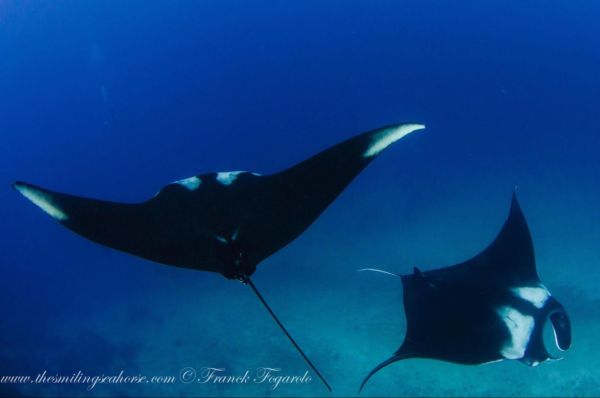
These rays predominantly live in temperate, subtropical and tropical waters throughout the world. They prefer water temperatures above 68 F (20 C). They can migrate as far as 620 miles (1000 km) from their homes and can dive down to 3,280 feet (1000 m).
Although both of the manta types are pelagic, giant oceanic manta rays prefer the open ocean, while reef mantas stay close to their reef. Reef mantas tend to be homebodies and do not migrate as far and as deep as the mobula birostris does. Consequently, it’s harder for divers to see giant mantas than their reef-based cousins.
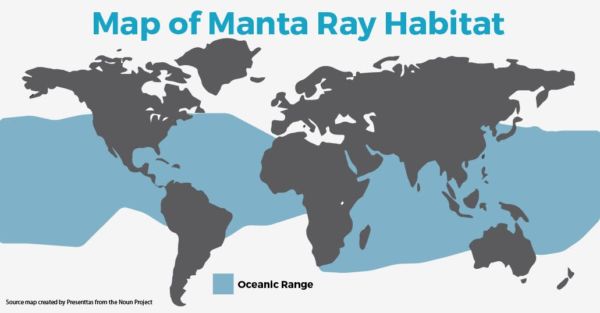 Mergui Archipelago in Myanmar and the Socorro Islands in Mexico are some of the best places to meet these gentle giants, while the Maldives and some places in Indonesia feature more regular sightings of reef mantas.
Mergui Archipelago in Myanmar and the Socorro Islands in Mexico are some of the best places to meet these gentle giants, while the Maldives and some places in Indonesia feature more regular sightings of reef mantas.
How Are Mantas Different from other mobulas?
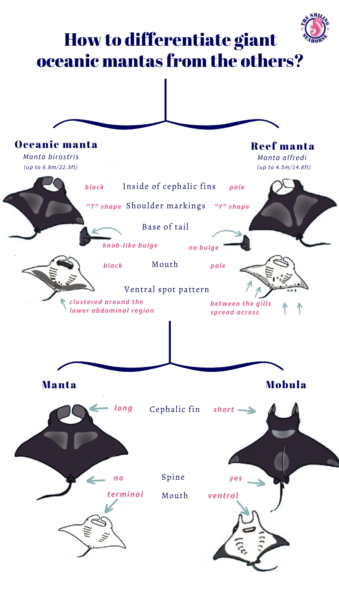 While they have more or less the same shape, giant oceanic mantas are much larger than other mobula types, but what really differentiates them is the position of their mouth. Manta rays have a forward-facing mouth, while the other mobula rays and devil rays have a downward-facing mouth.
While they have more or less the same shape, giant oceanic mantas are much larger than other mobula types, but what really differentiates them is the position of their mouth. Manta rays have a forward-facing mouth, while the other mobula rays and devil rays have a downward-facing mouth.
What’s the difference between the two most recognized varieties of mobulas?
Divers love many types of rays, but some of the most impressive are part of the genus Mobula. Until 2017, these creatures belonged to two categories — Mobula and Manta — but genetic studies now suggest that they are part of the same genus. The two main stars of this family are the Mobula birostris, or giant oceanic manta ray, and the Mobula alfredi, or reef manta ray. Although they may seem quite similar, some distinct characteristics allow us to differentiate between them.
The M. birostris, which is much bigger than its reef-dwelling counterpart, can be identified by the black coloring on the inside of its cephalic fins, while the M. alfredi’s has a pale cream color. The shape of their tail base also differs, with the presence of a knob-like bulge on the oceanic manta that is absent on the reef manta.
Just how big do giant oceanic manta rays get?
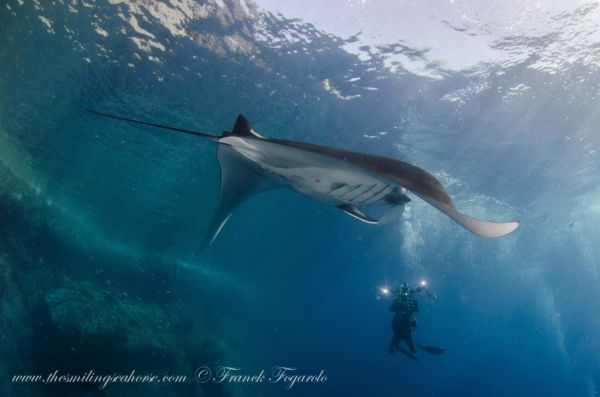
The largest recorded oceanic manta was about 30 feet (9 m) long and weighed over 2 tons. Reef mantas do not usually grow beyond 18 feet (5.5 m).
In the water, manta rays use their giant pectoral fins to move forward — and they are fast. Scientists also think them intelligent, as their brain-to-body size ratio is the biggest among cold-blooded fish.
What color are they?
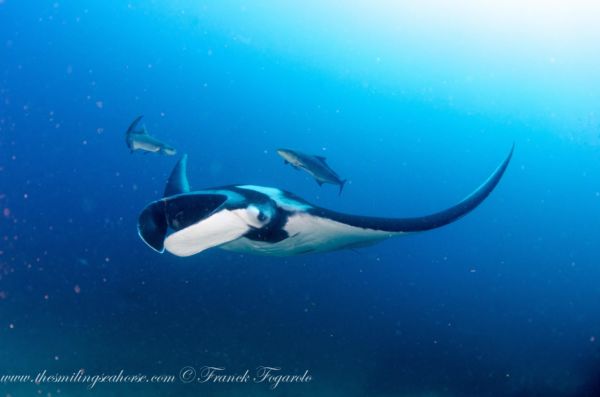
Many giant oceanic manta rays are dark gray on top, but some are entirely black, i.e. melanistic. In Australia, there have been rare sightings of a pink manta, which has baffled marine biologists. They have concluded that it has very likely undergone some form of genetic mutation.
What’s on the menu for Mobula birostris?
Until recently, scientists thought these magnificent creatures were mainly filter feeders like the blue whale. Recent studies, however, show that mantas receive only 27 percent of their nutrients from filter feeding. Eating solely zooplankton and crustaceans via filter-feeding does nourish them, but scientists now know that the remaining 73 percent of their diet comes from mesopelagic sources, which include deep-swimming sea fish.
How do theY behave in their natural habitat?
Lucky divers often see them swimming alone or in groups, and frequently while visiting cleaning stations, where cleaner wrasses tidy them up by eating the parasites off their smooth skin. They also jump out of the water occasionally. While scientists have not yet explained why they jump, they speculate that the animals are trying to free themselves from parasites or participating in a mating ritual. This breaching is fairly uncommon, but there are some photos of rare moments like this one at Black Rock in Myanmar, one of the favorite mating sites for oceanic mantas in the Indian Ocean.
Are they currently endangered?
The International Union for Conservation of Nature (IUCN) has labeled them vulnerable. One of the main threats to their existence is fishing them for Chinese alternative medicine, which values their gill rakers. They often become victims of bycatch as well, as they are easily caught in fishing nets because of their size. Another factor adding to their dwindling numbers is their very slow reproduction rate. They usually give birth to only one or two pups after an entire year of gestation and a female will then go two years before becoming pregnant again.
Giant oceanic manta rays currently enjoy protection in international waters, but in unregulated waters they are still victims of the fishing industry, making the need for their global protection quite urgent.
How should I dive with them?
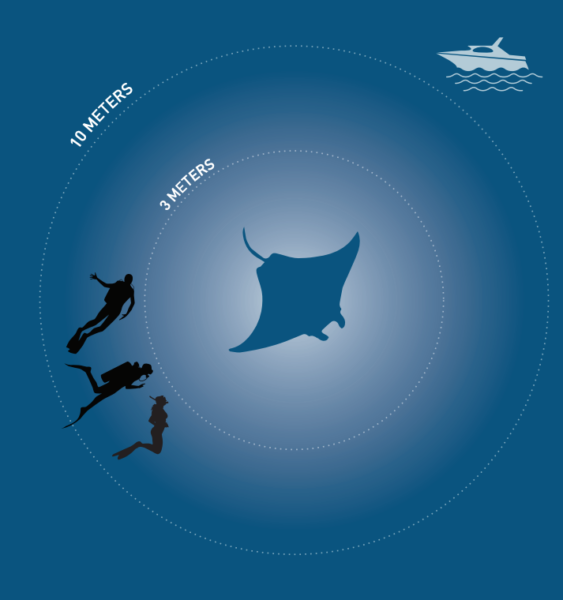
There’s some proper etiquette to follow for a greater chance of long-lasting, magical encounters with oceanic mantas while limiting your impact on their natural behavior.
When diving near them, swim gently and do not splash water. Use your fins sparingly and only when you’ve gone underwater. Approach them from their side where they can easily see you coming, and finally, do not chase them or attempt to touch them. They are wild, curious, and compassionate animals that deserve the utmost respect from any lucky onlooker.




 Private Scuba Tuition – Learn Scuba Skills.
Private Scuba Tuition – Learn Scuba Skills.
Leave a Reply
Want to join the discussion?Feel free to contribute!